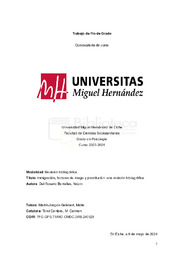Please use this identifier to cite or link to this item:
https://hdl.handle.net/11000/32600Full metadata record
| DC Field | Value | Language |
|---|---|---|
| dc.contributor.advisor | MARTÍN-ARAGÓN GELABERT, MAITE | - |
| dc.contributor.advisor | Terol Cantero, M Carmen | - |
| dc.contributor.author | Del Rosario Borralles, Yatzin | - |
| dc.contributor.other | Departamentos de la UMH::Psicología de la Salud | es_ES |
| dc.date.accessioned | 2024-07-22T10:41:24Z | - |
| dc.date.available | 2024-07-22T10:41:24Z | - |
| dc.date.created | 2024-06 | - |
| dc.identifier.uri | https://hdl.handle.net/11000/32600 | - |
| dc.description.abstract | Desde el inicio de los tiempos, el fenómeno migratorio ha estado presente en la vida del ser humano, siendo este uno de los procesos demográficos que más cambios produce en el tamaño, constitución y distribución de la población. Actualmente, a pesar de que la migración sea cada vez una actividad más común, no siempre se realiza bajo condiciones favorables, siendo cada vez más las causas negativas las que empujan a las personas a migrar. El objetivo de la siguiente revisión bibliográfica se centra en indagar en las causas de la migración y los factores de riesgo que pueden desembocar en el ejercicio de la prostitución en mujeres dentro de los flujos migratorios. Para la búsqueda de información se utilizaron las bases de datos Scielo, Mendeley y ScienceDirect. Tras la búsqueda y aplicación de los distintos criterios de exclusión, se obtuvieron 12 artículos finales. Los principales resultados de esta revisión resaltan la existencia de seis categorías que explican el porqué de las migraciones. Además, se destaca la doble discriminación que sufren las mujeres migrantes al llegar a los países de destino y cómo esta continua marginalización las vuelve más vulnerables a ser víctimas de trata y explotación sexual. | es_ES |
| dc.description.abstract | Since the beginning of time, the phenomenon of migration has been present in human life, being one of the demographic processes that produces the most changes in the size, constitution, and distribution of the population. Currently, despite migration becoming an increasingly common activity, it is not always carried out under favorable conditions, with negative causes increasingly pushing people to migrate. The objective of the following literature review is to investigate the causes of migration and the risk factors that can lead to the involvement of women in prostitution within migratory flows. The databases Scielo, Mendeley, and ScienceDirect were used for the information search. After searching and applying various exclusion criteria, 12 final articles were obtained. The main results of this review highlight the existence of six categories that explain the reasons for migration. Additionally, it emphasizes the double discrimination that migrant women suffer upon arriving in destination countries and how this continuous marginalization makes them more vulnerable to becoming victims of trafficking and sexual explotation. | es_ES |
| dc.format | application/pdf | es_ES |
| dc.format.extent | 26 | es_ES |
| dc.language.iso | spa | es_ES |
| dc.publisher | Universidad Miguel Hernández de Elche | es_ES |
| dc.rights | info:eu-repo/semantics/openAccess | es_ES |
| dc.rights.uri | http://creativecommons.org/licenses/by-nc-nd/4.0/ | * |
| dc.subject | Migración | es_ES |
| dc.subject | motivos | es_ES |
| dc.subject | mujeres migrantes | es_ES |
| dc.subject | prostitución | es_ES |
| dc.subject | Migration | es_ES |
| dc.subject | reasons | es_ES |
| dc.subject | migrant women | es_ES |
| dc.subject | prostitution | es_ES |
| dc.subject.other | CDU::1 - Filosofía y psicología::159.9 - Psicología | es_ES |
| dc.title | Inmigración, factores de riesgo y prostitución: una revisión bibliográfica | es_ES |
| dc.type | info:eu-repo/semantics/bachelorThesis | es_ES |

View/Open:
TFG Yatzin Del Rosario (REVISADO28mayo2024).docx.pdf
608,05 kB
Adobe PDF
Share:
Admin Tools
.png)
